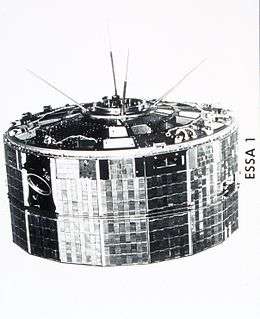ESSA-1
 ESSA 1 | |
| Mission type | Weather satellite |
|---|---|
| Operator | ESSA/NASA |
| COSPAR ID | 1966-008A |
| SATCAT no. | 1982 |
| Spacecraft properties | |
| Manufacturer | RCA Astro |
| Launch mass | 304 kilograms (670 lb)[1] |
| Start of mission | |
| Launch date | February 3, 1966, 07:41:23 UTC[2] |
| Rocket | Delta C |
| Launch site | Cape Canaveral LC-17A |
| End of mission | |
| Disposal | Decommissioned |
| Deactivated | June 12, 1968[3] |
| Orbital parameters | |
| Reference system | Geocentric |
| Regime | Low Earth |
| Semi-major axis | 7,115.60 kilometers (4,421.43 mi) |
| Eccentricity | 0.0083082 |
| Perigee | 685 kilometers (426 mi) |
| Apogee | 803 kilometers (499 mi) |
| Inclination | 97.94 degrees |
| Period | 99.56 minutes |
| Epoch | December 7, 2013, 20:11:52 UTC[4] |
|
TOS | |
ESSA-1 (or OT-3) was a spin-stabilized operational meteorological satellite. Its name was derived from that of its oversight agency, the Environmental Science Services Administration (ESSA).
Launch
ESSA-1 was launched on February 3, 1966 at 07:41 UTC. It was launched atop a Delta rocket from Cape Canaveral, Florida. The spacecraft had a mass of 304 kilograms (670 lb) at the time of launch. ESSA-1 had an inclination of 97.91°, and an orbited the earth once every 100 minutes. Its perigee was 702 kilometers (379 nmi) and its apogee was 845 kilometers (456 nmi).
ESSA-1 had a similar design to that of the TIROS satellite series. It was an 18-sided right prism, measuring 107 centimeters (42 in) across opposite corners and 56 centimeters (22 in). It had a reinforced baseplate, which carried most of the subsystems and a cover assembly (hat). ESSA-1 had approximately 10,000 1-cm by 2-cm solar cells, which charged 21 nickel–cadmium batteries. ESSA-1 was designed to take pictures of daytime cloud cover, record them, and transmit them when it was in range of a ground acquisition station.
The satellite spin rate and attitude were determined primarily by a magnetic attitude spin coil (MASC). The MASC was a current-carrying coil mounted in the cover assembly. The magnetic field induced by the coil interacted with that of the Earth's magnetic field, and provided the necessary torque to maintain a desired spin rate of 9.225 revolutions per minute (rpm). Five small solid-fuel thrusters mounted on the baseplate provided a secondary means of controlling the spin rate.
ESSA-1 operated normally until October 6, 1966, when the camera system failed. The spacecraft was fully deactivated on May 8, 1967, after being left on for an additional period of time for engineering purposes.
References
- ↑ "ESSA 1". National Space Science Data Center. Retrieved December 8, 2013.
- ↑ McDowell, Jonathan. "Launch Log". Jonathan's Space Page. Retrieved December 8, 2013.
- ↑ "ESSA". NASA Science. Archived from the original on December 11, 2013. Retrieved December 8, 2013.
- ↑ "ESSA 1 (OT-3) Satellite details 1966-008A NORAD 1982". N2YO. December 7, 2013. Retrieved December 8, 2013.
![]()
External links
- "NASA - NSSDC - Spacecraft - Details - ESSA 1". NSSDC. May 14, 2012. Retrieved January 1, 2013.
- "Tiros OT-3 spacecraft handling plan" (PDF). NASA. October 1, 1965. Retrieved January 1, 2013.
- "Operational procedures for telemetry data processing for the TIROS 9 and OT-3 meteorological satellite system" (PDF). NASA. December 17, 1965. Retrieved January 1, 2013.
- "Instruction and operating handbook Tiros 9 and OT-3 meteorological satellite system" (PDF). NASA. December 27, 1965. Retrieved January 1, 2013.
- "Early orbit and attitude determination plan and prelaunch analysis for the satellite TIROS OT-3" (PDF). NASA. January 1, 1966. Retrieved January 1, 2013.
- "Tiros OT-3 spacecraft handling plan" (PDF). NASA. January 7, 1966. Retrieved January 1, 2013.
- "Alignment and calibration data for the TIROS OT-3 meteorological satellite" (PDF). NASA. January 17, 1966. Retrieved January 1, 2013.
- "ESSA 1 (TIROS OT-3) Meteorological Satallite System, Vol. I" (PDF). NASA. April 20, 1966. Retrieved January 1, 2013.
- L. J. Allison (May 1, 1972). "The development of hurricane Inez, 1966, as shown by satellite nighttime radiometric and daytime television coverage" (PDF). NASA. Retrieved January 1, 2013.
